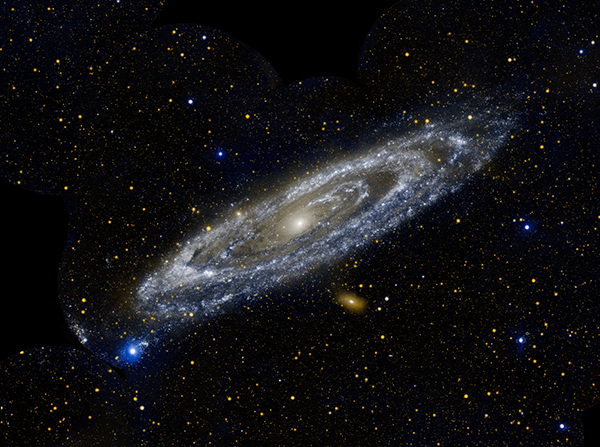More Information about M31 (the Andromeda Galaxy)

M31, also known as the Andromeda galaxy, can be seen with the naked eye in the constellation of Andromeda. M31 our nearest spiral galaxy neighbor. The Milky Way has a number of dwarf companion galaxies that lie closer than M31, like the Large and Small Magellanic Clouds, but M31 is the nearest major galaxy neighbor. Andromeda is also the largest galaxy in the Local Group, the cluster of galaxies of which the Milky Way is also a member.
Andromeda could be seen by the earliest people; however, it was not recognized as a galaxy until relatively recently. Through early telescopes, Andromeda was seen as a fuzzy spot in the sky and was assumed to be a nebula of gas lying within the Milky Way. In 1887, Isaac Roberts took the first photograph of Andromeda, which revealed its spiral structure. But even then, Andromeda was still assumed to be a local nebula.
In 1917, Heber Curtis observed a nova in Andromeda. Combing the photographic records, he found a number of other nova, and discovered that they were much fainter in Andromeda than elsewhere in the Milky Way. This bolstered the "island universe" hypothesis that spiral nebulae, like Andromeda, were actually separate from the Milky Way. Ultimately, this hypothesis was shown to be true by Edwin Hubble in 1925. He identified Cepheid variable stars in Andromeda, which enabled him to measure its distance. The measured distance put Andromeda firmly outside the Milky Way.
Modern measurements have put the Andromeda galaxy at about 2.5 million light years from Earth.
Want to know even more about M31? Here are some resources:
- Andromeda Galaxy on Wikipedia
- Hubble's High-Definition Panoramic View of the Andromeda Galaxy
- Swift Makes Best-ever Ultraviolet Portrait of Andromeda Galaxy



